Standards Worldwide
Standards Worldwide
Phone +49 30 58885700-07

Standard [CURRENT]
ASTM E 521:2025
Standard Practice for Investigating the Effects of Neutron Radiation Damage Using Charged-Particle Irradiation
- Publication date
- 2025
- Original language
- English
- Pages
- 24
- Publication date
- 2025
- Original language
- English
- Pages
- 24
- DOI
- https://dx.doi.org/10.1520/E0521-25
Product information on this site:
Quick delivery via download or delivery service
Buy securely with a credit card or pay upon receipt of invoice
All transactions are encrypted
Short description
1.1 This practice provides guidance on performing charged-particle irradiations of metals and alloys, although many of the methods may also be applied to ceramic materials. It is generally confined to studies of microstructural and microchemical changes induced by ions of low-penetrating power that come to rest in the specimen. Density changes can be measured directly and changes in other properties can be inferred. This information can be used to estimate similar changes that would result from neutron irradiation. More generally, this information is of value in deducing the fundamental mechanisms of radiation damage for a wide range of materials and irradiation conditions. 1.2 Where it appears, the word "simulation" should be understood to imply an approximation of the relevant neutron irradiation environment for the purpose of elucidating damage mechanisms. The degree of conformity can range from poor to nearly exact. The intent is to produce a correspondence between one or more aspects of the neutron and charged-particle irradiations such that fundamental relationships are established between irradiation or material parameters and the material response. 1.3 The practice appears as follows: Section Significance and Use 4 Specimen Preparation 9 Irradiation Techniques (including Helium Injection) 10 Damage Calculations 11 Pos-tirradiation Examination 12 - 14 Reporting of Results 15 Correlation and Interpretation 16 - 20 1.4 The values stated in SI units are to be regarded as standard. The values given in parentheses after SI units are provided for information only and are not considered standard. 1.5 This standard does not purport to address all of the safety concerns, if any, associated with its use. It is the responsibility of the user of this standard to establish appropriate safety, health, and environmental practices and determine the applicability of regulatory limitations prior to use. 1.6 This international standard was developed in accordance with internationally recognized principles on standardization established in the Decision on Principles for the Development of International Standards, Guides and Recommendations issued by the World Trade Organization Technical Barriers to Trade (TBT) Committee.
ICS
27.120.10
DOI
https://dx.doi.org/10.1520/E0521-25
Also available in
Loading recommended items...
Loading recommended items...
Loading recommended items...
Loading recommended items...
